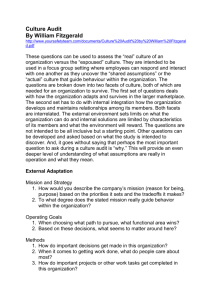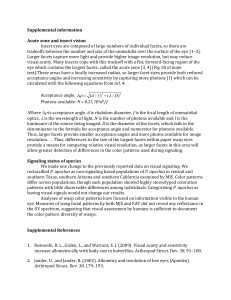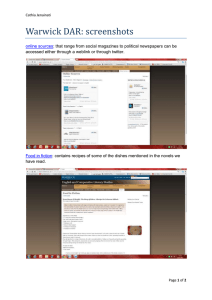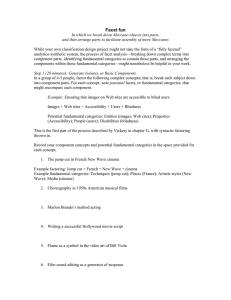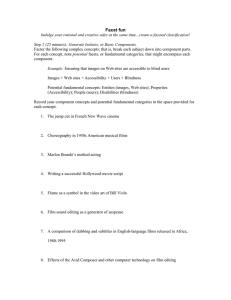Towards a Visualization of Multi
advertisement
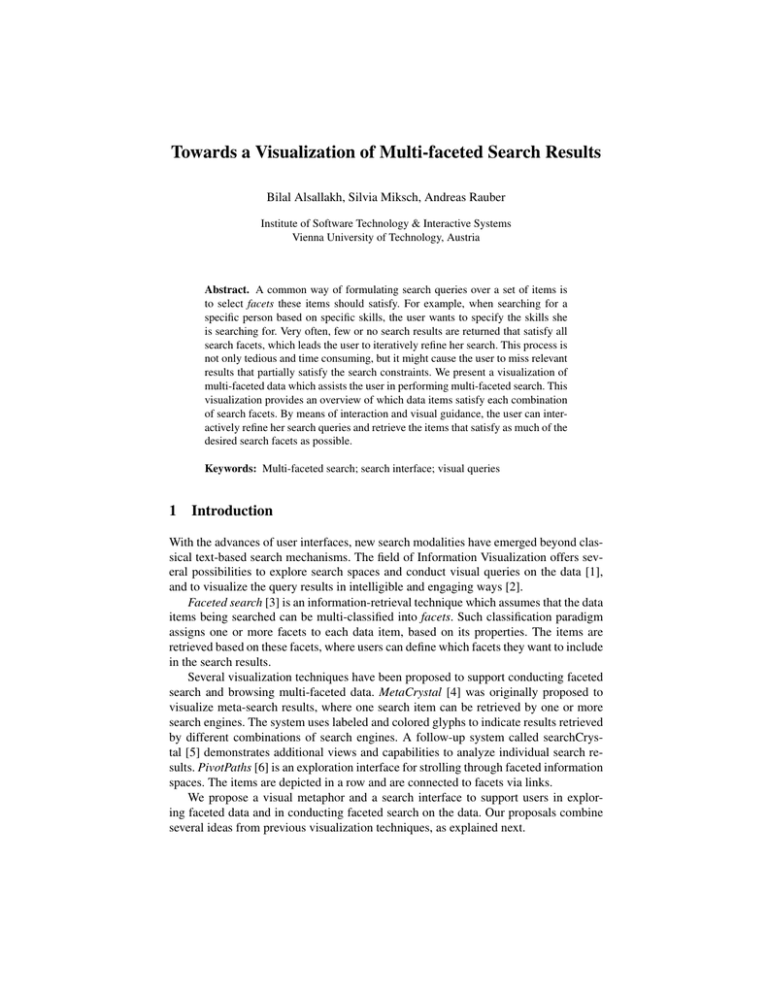
Towards a Visualization of Multi-faceted Search Results Bilal Alsallakh, Silvia Miksch, Andreas Rauber Institute of Software Technology & Interactive Systems Vienna University of Technology, Austria Abstract. A common way of formulating search queries over a set of items is to select facets these items should satisfy. For example, when searching for a specific person based on specific skills, the user wants to specify the skills she is searching for. Very often, few or no search results are returned that satisfy all search facets, which leads the user to iteratively refine her search. This process is not only tedious and time consuming, but it might cause the user to miss relevant results that partially satisfy the search constraints. We present a visualization of multi-faceted data which assists the user in performing multi-faceted search. This visualization provides an overview of which data items satisfy each combination of search facets. By means of interaction and visual guidance, the user can interactively refine her search queries and retrieve the items that satisfy as much of the desired search facets as possible. Keywords: Multi-faceted search; search interface; visual queries 1 Introduction With the advances of user interfaces, new search modalities have emerged beyond classical text-based search mechanisms. The field of Information Visualization offers several possibilities to explore search spaces and conduct visual queries on the data [1], and to visualize the query results in intelligible and engaging ways [2]. Faceted search [3] is an information-retrieval technique which assumes that the data items being searched can be multi-classified into facets. Such classification paradigm assigns one or more facets to each data item, based on its properties. The items are retrieved based on these facets, where users can define which facets they want to include in the search results. Several visualization techniques have been proposed to support conducting faceted search and browsing multi-faceted data. MetaCrystal [4] was originally proposed to visualize meta-search results, where one search item can be retrieved by one or more search engines. The system uses labeled and colored glyphs to indicate results retrieved by different combinations of search engines. A follow-up system called searchCrystal [5] demonstrates additional views and capabilities to analyze individual search results. PivotPaths [6] is an exploration interface for strolling through faceted information spaces. The items are depicted in a row and are connected to facets via links. We propose a visual metaphor and a search interface to support users in exploring faceted data and in conducting faceted search on the data. Our proposals combine several ideas from previous visualization techniques, as explained next. 2 2 The Proposed Search Interface The search facets used to classify data items define sets over these items. Each of these sets contains the items that satisfy the respective facet. Analyzing which facets can be satisfied together is hence equivalent to analyzing the overlaps (i.e. intersections) between the respective sets. A variety of techniques has been proposed to visualize overlapping sets [7]. These techniques vary in how they visually represent the sets, which set-related tasks they support, and how scalable they are in the number of sets and elements. Our visualization approach for multi-faceted data is based on the Radial Sets [8] technique for visualizing overlapping sets. This technique uses a radial layout to show the search facets in separate regions, with a histogram in each region showing the data items that satisfy each facet (Fig. 1). We distinguish between the items in each facet by how many other facets they satisfy. Items that satisfy only one facet are included at the outermost histogram bars next to the facet label. Items that satisfy two facets are included in the next histogram bar, and so on. Hence, the histogram bars closer to the central area contain items that satisfy to the largest possible number of facets. It is possible to see immediately from the visualization, if items satisfying a certain search facet tend to satisfy other facets or not. For example items satisfying ‘facet A’ in Fig. 1 cannot satisfy other search facets, since all of them lie in the 1st and outermost bar in the respective region. On the other hand, all items satisfying ‘facet D’ satisfy three other facets, since all of them lie in the 4th and innermost bar in the respective region. Fig. 1. Overview Visualization of multi-faceted data. The radial histograms represent items that match each facet, grouped according to how many other facets they match. The bubbles represent combinations of facets grouped by the the number of facets involved in them. 3 Besides showing how data items are distributed according to individual facets, the visualization also shows how these items are distributed into facet combinations. These combinations are visualized as bubbles in the inner area, organized into concentric rings (Fig. 1). The outermost ring contains combinations between pairs of facets, the next ring contains combinations between three facets, and the innermost ring contains combinations between four facets. The size of a bubble encodes the number of data items that satisfy the respective facet combination. The bubbles are sorted by size in the respective ring. To avoid visual clutter, the visualization initially does not indicate which facets are involved in a specific bubble. This information can be obtained on demand by hovering the mouse over a bubble. The respective facet combination is shown in a tooltip and can additionally be highlighted by means of visual links between the bubble and the respective regions. Alternatively, links can be depicted to show facet combinations of certain degrees. Fig. 2 show combinations between pairs of facets, where the link thickness indicates the number of items that satisfy the respective pair. It is possible to select the rings starting for a specific number of facets, to focus on items that satisfy as many facets as possible. Interaction allows selecting certain items in the visualization to explore these items in detail. The search interface contains multiple views that allow showing the information at multiple levels of detail (Fig. 2). Two views on the left side contain bar charts that show how many items belong to each facet, and how many facets the items can belong to. The central view shows the facets and their combinations, with possibility to select certain items. Selected items are shown in detail as a list on the right side. They are also highlighted in the histograms to indicate to which facets or facet combinations these items belong. The selection can hence be refined using set operations by iteratively clicking on further visual elements in any of the views, in combination with certain keyboard modifiers 1 . 3 Discussion and Conclusion The presented search interface offers a compact overview of how many results will be retrieved according to different facets and facet combinations. The visual metaphor scales up to 20-30 search facets that are shown in the sectors. The ‘Items by #facets’ histogram indicates the largest number of facets that can be satisfied at once. Based on this number, the user can select the most relevant facets for her search query. For example, the user can start by selecting ‘English’ and an important skill when searching for a job candidate. This highlights matching portions in all histograms for all facets. Based on this visual guidance, the user can iteratively check and decide which facets can still be satisfied, and narrow the search by combining selections using ‘AND’ operator. The user needs to learn the visual metaphor in order to make effective use of the presented search interface. An evaluation study is needed to assess the usability and effectiveness of the proposed visual interface, and to refine the design accordingly. Also, more work is needed to allow users to interactively define their search facets, and to specify which ones are required and which ones are optional in the search results. 1 A video and an interactive prototype that demonstrate possible interactions are available at www.radialsets.org 4 Fig. 2. The multi-faceted search interface encompassing multiple views. (a) The search facets sorted by the number of items that satisfy them. (b) The data items grouped according to how many facets they satisfy (i.e. facet degrees). (c) The visualization of how data items satisfy different facets and facet combinations. Links between facets are shown instead of bubbles, to indicate how many items satisfy the respective pair of facets. (d) A scrollable list view of selected data items that satisfy selected facets (depicted in red in the other views). References 1. Smith, G., Czerwinski, M., Meyers, B.R., Robertson, G., Tan, D.: Facetmap: A scalable search and browse visualization. Visualization and Computer Graphics, IEEE Transactions on 12(5) (2006) 797–804 2. Dörk, M., Carpendale, S., Williamson, C.: Fluid Views: a zoomable search environment. In: Proceedings of the International Working Conference on Advanced Visual Interfaces, ACM (2012) 233–240 3. Tunkelang, D.: Faceted search. Synthesis lectures on information concepts, retrieval, and services 1(1) (2009) 1–80 4. Spoerri, A.: MetaCrystal: visual interface for meta searching. In: ACM SIGCHI Conference on Human Factors in Computing Systems (CHI) - extended abstracts. Volume 24. no 29., ACM (2004) 1558–1558 5. Spoerri, A.: Visual mashup of text and media search results. In: International Conference Information Visualization (IV), IEEE (2007) 216–221 6. Dork, M., Henry Riche, N., Ramos, G., Dumais, S.: PivotPaths: Strolling through faceted information spaces. Visualization and Computer Graphics, IEEE Transactions on 18(12) (2012) 2709–2718 7. Alsallakh, B., Micallef, L., Aigner, W., Hauser, H., Miksch, S., Rodgers, P.: Visualizing sets and set-typed data: State-of-the-art and future challenges. In: Eurographics conference on Visualization (EuroVis) State of The Art Reports, Eurographics (2014) 8. Alsallakh, B., Aigner, W., Miksch, S., Hauser, H.: Radial Sets: Interactive visual analysis of large overlapping sets. Visualization and Computer Graphics, IEEE Transactions on 19(12) (2013) 2496–2505

